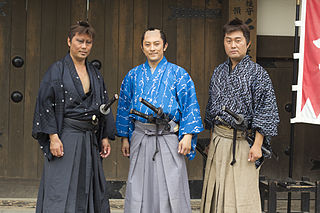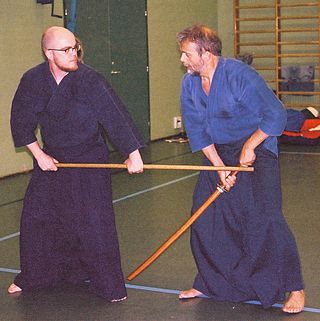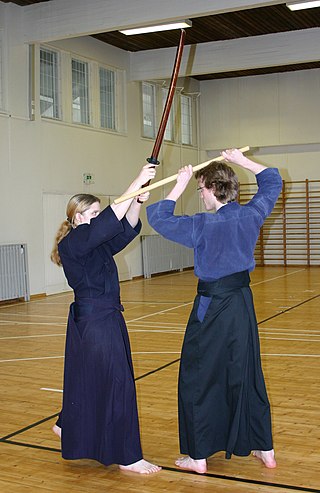Iaidō (居合道), abbreviated iai (居合), is a Japanese martial art that emphasizes being aware and capable of quickly drawing the sword and responding to sudden attacks.

Iaijutsu (居合術) is a combative quick-draw sword technique. This art of drawing the Japanese sword, katana, is one of the Japanese koryū martial art disciplines in the education of the classical warrior (bushi).
A jō is an approximately 1.27-metre (4.2 ft) wooden staff, used in some Japanese martial arts. The martial art of wielding the jō is called jōjutsu or jōdō. Also, aiki-jō is a set of techniques in aikido which uses the jō to illustrate aikido's principles with a weapon. The jō staff is shorter than the bō. Today, the jō is still used by some Japanese police forces.

Jidaigeki is a genre of film, television, video game, and theatre in Japan. Literally meaning "period dramas", they are most often set during the Edo period of Japanese history, from 1603 to 1868. Some are set much earlier—Portrait of Hell, for example, is set during the late Heian period—and the early Meiji era is also a popular setting.

Nakayama Hakudō, also known as Nakayama Hiromichi, was a Japanese martial artist and founder of the iaidō style Musō Shinden-ryū. He received hanshi ranks in kendō, iaidō, and jōdō from the All Japan Kendo Federation. In addition, he held an instructor's license in Shintō Musō-ryū and a Menkyo kaiden in Shindō Munen-ryū making him the 7th sōke of that system. Nakayama was also one of the masters of the Shimomura-ha Musō Shinden Eishin-ryū, iaijutsu.
Shinto-ryu can refer to several styles of classical Japanese swordsmanship used by the samurai:

Shintō Musō-ryū, or Shindō Musō-ryū (神道夢想流), most commonly known by its practice of jōdō, is a traditional school (koryū) of the Japanese martial art of jōjutsu, or the art of wielding the short staff (jō). The technical purpose of the art is to learn how to defeat a swordsman in combat using the jō, with an emphasis on proper combative distance, timing and concentration. The system includes teachings of other weapon systems which are contained in Shintō Musō-ryū as auxiliary arts. The school is sometimes abbreviated as SMR.

Musō Gonnosuke Katsuyoshi (夢想權之助勝吉) was a samurai of the early 17th century and the traditional founder of the Koryu school of jojutsu known as Shintō Musō-ryū (神道夢想流/神道無想流). He is perhaps most famous for his duels with the legendary swordsman Miyamoto Musashi.
Kusarigamajutsu (鎖鎌術:くさりがまじゅつ) is the art of using the Japanese weapon kusarigama.

Uchida-ryū Tanjōjutsu (内田流短杖術), also known as Sutekki-Jutsu, is a Japanese martial arts school of tanjojutsu, originally devised by Shinto Muso-ryu practicitioner Uchida Ryogoro (1837-1921) as a way to utilize the western-style walking stick into a weapon of self-defence. The tanjo is not to be confused with the pre-meji era short stick hanbō.

Uchida Ryōgorō Shigeyoshi, , was a Japanese jojutsu practitioner, ranked menkyo in the Japanese martial art of Shintō Musō-ryū. He is the creator of the gendai budo Uchida Ryu Tanjojutsu, originally known as Sutteki jutsu or "stick method".

Isshin-ryū (一心流) is a traditional school of the Japanese martial art of kusarigamajutsu, the art of using the chain and scythe (kusarigama). Its exact origin is disputed, and may have been founded as early as the 14th century by the samurai Nen Ami Jion 念阿弥慈恩 (b.1351-?), but the modern-day techniques were compiled and incorporated no later than the 17th century, by the unification of Harayuki Uemon Ujisada (原志右衛門氏貞), hence the name. It is preserved in Shintō Musō-ryū as a "heiden".
Kasumi Shintō-ryū Kenjutsu (霞神道流剣術), or, is one of the names used to describe the collection of sword-versus-sword training-forms (kata) for the long and short sword found exclusively in the Japanese martial arts system Shintō Musō-ryū (SMR). The system comprises 12 standing forms, 8 of which are for the longsword (Odachi) and 4 with the short sword (kodachi).

Ikkaku-ryū juttejutsu is a school of juttejutsu that, as the equivalent to its sister variant Chūwa-ryū tankenjutsu (中和流短剣術), is taught alongside traditional school (ko-ryū) of Japanese martial arts, Shintō Musō-ryū. It is composed of 24 forms (kata) divided into two series. It was created by the third Shintō Musō-ryū (SMR) Headmaster, Matsuzaki Kinu'emon Tsunekatsu in the late 17th century.

Zen Nihon Kendō Renmei Jōdō, or Seitei Jōdō in short, is a modern form of jōdō created by Japanese martial artist Shimizu Takaji and presented to the All Japan Kendo Federation in 1968.

Jōdō (杖道), meaning "the way of the jō", or Jōjutsu (杖術) is a Japanese martial art using a short staff called jō. The art is similar to bōjutsu, and is strongly focused upon defense against the Japanese sword. The jō is a short staff, usually about 3 to 5 feet long.
Ittatsu-ryū (一達流) is a traditional school (koryū) of the Japanese martial art of hojōjutsu. Today, Ittatsu-ryū has been assimilated into the traditional school of Shintō Musō-ryū. This particular school of hojōjutsu was created in the late 17th century by Matsuzaki Kinueimon Shigekatsu, the third Shintō Musō-ryū headmaster. The modern Ittatsu-ryū system comprises 24 training-forms (kata), grouped into 3 different series.
Shintō Musō-ryū, or Shindō Musō-ryū (神道夢想流) is a traditional (ko-ryū) school of the Japanese martial art of jōjutsu, the art of handling the Japanese short staff (jō). The art was created with the purpose of defeating a swordsman in combat using the jō, with an emphasis on proper distance, timing and concentration. Additionally, a variety of other weapons are also taught.
Shindō Munen-ryū or Shintō Munen-ryū (神道無念流) is a Japanese koryū martial art school founded by Fukui Hyōemon Yoshihira (福井兵右衛門嘉平) in the early 18th century. The style rapidly gained popularity throughout Japan due to the efforts of Togasaki Kumataro, Okada Junmatsu, Saito Yakuro, and his sons Shintaro and Kannosuke.









